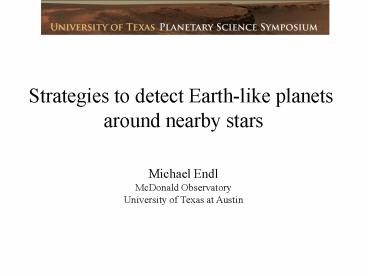Strategies to detect Earth-like planets - PowerPoint PPT Presentation
1 / 8
Title:
Strategies to detect Earth-like planets
Description:
Earth imparts on the sun a velocity change of 10 cm/s over 1 year! Completely new challenge! ... m class telescopes with high precision velocity spectrographs ... – PowerPoint PPT presentation
Number of Views:21
Avg rating:3.0/5.0
Title: Strategies to detect Earth-like planets
1
Strategies to detect Earth-like planets around
nearby stars Michael Endl McDonald
Observatory University of Texas at Austin
2
Strategies to detect Earth-like planets around
nearby stars
The solar neighborhood
3
Strategies to detect Earth-like planets around
nearby stars
Transit method advantage planetary radius
Doppler velocities gt mean density
disadvantage requires space telescope
(CoRoT, Kepler), large sample Doppler method
advantage cheap, ground-based,
well-established disadvantage only minimum
mass, large data quantities needed Astrometry
advantage true masses (with Doppler), good
for nearby stars! disadvantage extreme
precision (SIM) Micro-Lensing advantage
sensitive to habitable zone planets disadvanta
ge requires star to move between us and
background star Direct Imaging advantage
it's a picture! (brightness, colors...)
disadvantage it's only a picture (mass?
orbit?,...), new telescopes (TPF)
4
Strategies to detect Earth-like planets around
nearby stars
- Doppler (or radial) velocity method
- measurement of the tiny velocity variations of
the star due to the presence of an unseen
planetary companion. This is done by determining
the small Doppler shift of stellar lines - over many years.
- Systematic errors have to be under control!
- Current highest precision 1 m/s
- Earth imparts on the sun a velocity change of
10 cm/s over 1 year! - Completely new challenge!
- Stellar variability
- p-mode oscillations few minutes, can be averaged
out - rotational modulation cool spots, Prot 30 days
- magnetic activity cycles t 11 years
5
Strategies to detect Earth-like planets around
nearby stars
6
Strategies to detect Earth-like planets around
nearby stars
Alpha Centauri campaign at the McLellan 1 m
telescope at Mt. John Observatory (NZ) with
Stuart Barnes John Hearnshaw
7
Strategies to detect Earth-like planets around
nearby stars
8
Strategies to detect Earth-like planets around
nearby stars
Doppler detection of Earth analogs is possible
with a precision of 2-3 m/s and 50,000
measurements over 4 -5 yrs! IF error budget is
dominated by white noise! Pilot
Study semi-dedicated telescope/spectrograph for
intensive multi-year campaign on Alpha
Cen. Future Global network of dedicated 2-4 m
class telescopes with high precision velocity
spectrographs gt monitor all nearby 10-20
solar-type stars over 5 years gt after a decade
we would have an Input Catalog of candidates
for ambitious space missions like the
Terrestrial Planet Finder (TPF), allows detailed
follow-up observations































